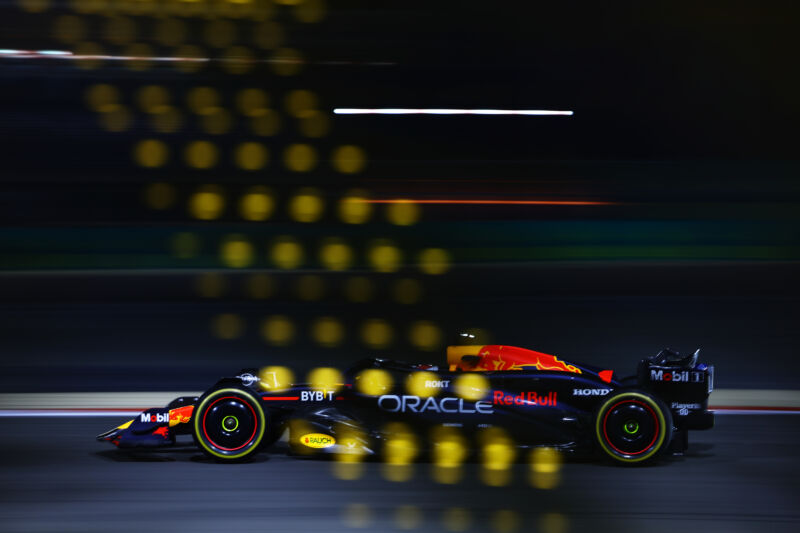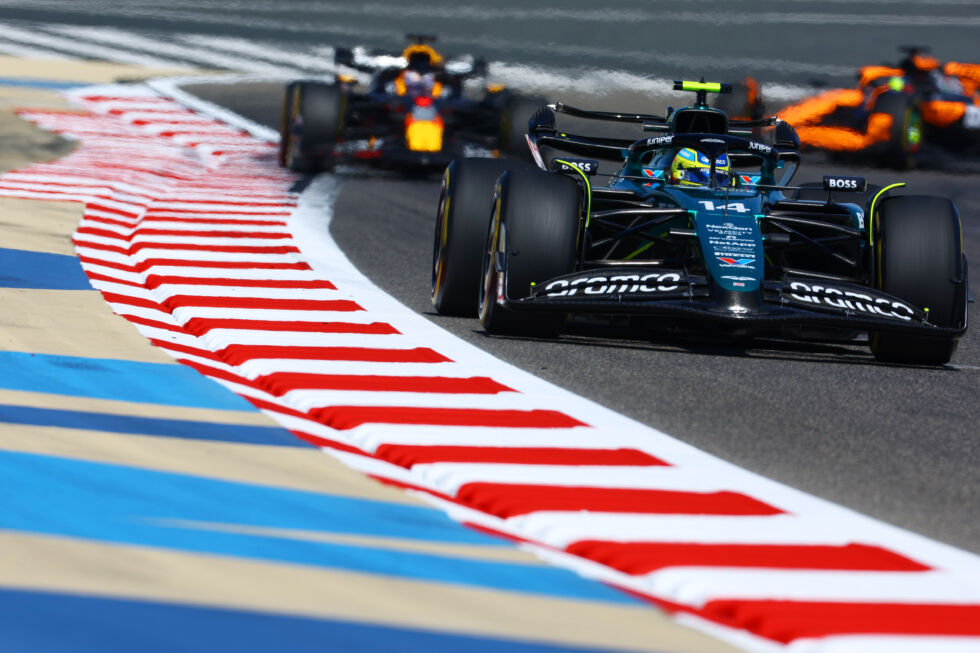
Enlarge / While it’s hard to read too much into preseason testing times, it’s also hard to see anyone really challenging Red Bull or Max Verstappen for outright speed.
Mark Thompson/Getty Images
The sixth season of Drive to Survive, Netflix’s blockbuster behind-the-scenes sportumentary, went live today. This isn’t a review of that. Instead, for the past few days my attention has been turned to Formula 1’s preseason testing, which got underway on Wednesday morning at the Bahrain International Circuit in Bahrain.
In the olden days, preseason testing was a thing you’d read about in the specialty press—a reason to buy a copy of Autosport in February, if you will. There was a lot more of it back then, too; up to five official preseason tests, although it was unusual for a team to attend all of them.
In F1’s current era, there isn’t really time for so much testing, even if it weren’t strictly limited by the rules. The first race of what should be a 24-race calendar takes place next Saturday (March 2), with the final round, also in the Middle East, not scheduled until December 8. Contrast that with the early 2000s, when a season might run for 16 or 17 races between early March and mid-October.

Enlarge / This year the teams get three test days ahead of 24 race weekends.
Mark Thompson/Getty Images
Back then, none of the preseason testing would be broadcast to fans, either. Now, thanks to F1’s streaming platform, there are 24 hours of coverage to keep you occupied, with each eight-hour day covered by an English-language commentary team that combines some of F1’s own (yay, Sam Collins!) with some voices more familiar to Sky’s (and therefore ESPN’s) coverage, like the always-excellent Anthony Davidson.
While I imagine the committed F1 fan will also add in all 10 hours of DtS season six, you’re unlikely to get nearly as good of a technical insight into the new cars or come away with a better understanding of what the drivers are doing in the cars to extract such speed so consistently.
Don’t read much into the times
An important thing to know about preseason testing is that it’s very difficult to read much into any of the lap times. The cars aren’t subject to scrutineering checks the way they are during a race weekend, and some teams aren’t above putting together a so-called glory lap to top the timesheets and maybe attract a sponsor or two.
These days, that’s far less likely than sandbagging—intentionally driving a car slowly at certain points during a lap, perhaps—to hide one’s true pace. Instead, each team has its own run plan designed to satisfy the needs of the engineers.
Rarer still is the team that shows up with something revolutionary that blows everyone else into the weeds. But it does happen—check out Keanu Reeves’ Brawn: The Impossible F1 Story for a 21st-century example of such a sporting fairytale.
What’s changed in the offseason?
There have been no real changes to the technical regulations for this year, but every team has a new car that reflects their better understanding of how the current ruleset needs to be best exploited.
The key to generating useful aerodynamic downforce from a current F1 car’s ground effect is to keep the car as stable as possible under both braking and accelerating, which means controlling dive at the front axle and countering lift at the rear axle. For 2024, some teams have had a fundamental rethink of how they do that.
-
George and Lewis will push the WhatsApp button to talk to their race engineers.
Kym Illman/Getty Images
-
Ferrari topped the time sheets on days two and three, and the car looks fast in long runs as well as qualifying simulations.
Mario Renzi – Formula 1/Formula 1 via Getty Images
-
Mercedes (and the teams it supplies engines to) have moved to rear pushrod suspension.
Peter Fox – Formula 1/Formula 1 via Getty Images
-
Sauber is a good example of a team that’s kept as much of the car bare carbon as possible.
Mark Thompson/Getty Images
-
Visa Cash App RB is a daft name for a team. And while I’m complaining, should Red Bull really be allowed to own two teams? I can’t think of another sport where someone can own more than one franchise.
Rudy Carezzevoli/Getty Images
-
Long-serving Red Bull team boss Christian Horner is looking less secure in his position thanks to an ongoing internal investigation regarding inappropriate behavior towards a subordinate.
Mark Thompson/Getty Images
-
There’s a new boss at Haas, Ayao Komatsu.
NDREJ ISAKOVIC/AFP via Getty Images
-
Aston Martin’s car looks like it handles well, but might not have the pace of either Ferrari or Mercedes.
Mark Thompson/Getty Images
-
You’d think two French teammates in a French team might be a recipe for harmony, but Esteban Ocon and Pierre Gasly don’t really have the best relationship.
Clive Mason/Getty Images
-
Alex Albon drove last year’s Williams into some points-paying positions when the track suited the car. This year Williams says it has a car with a much wider operating window.
Rudy Carezzevoli/Getty Images
Kick Sauber and RB (yes, those are real names) are joining Red Bull and McLaren in using pullrods (instead of pushrods) for their front suspension. Meanwhile, Mercedes, Aston Martin, and Williams have switched to rear pushrods, which interfere less with the underbody aerodynamics, leaving just Ferrari and their client Haas sticking with rear pullrods.
The floor might generate more of the downforce now, but that doesn’t mean bodywork isn’t important. Red Bull’s looks significantly different, incorporating ideas tried with varying success at other teams like Ferrari’s “bathtub sidepod” or Mercedes’ “zero sidepod.”
Truthfully, the most immediately noticeable difference from last year has been more teams opting to forgo a full-body paint job, preferring large expanses of bare carbon fiber in the name of saving another kilo or two. And if you’re looking for nerd trivia to bore impress someone with, the Mercedes drivers now have a WhatsApp button on their steering wheel to use to radio back to the pits.